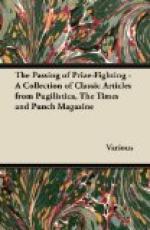Miss MARIE HARRISON has investigated the condition of Ireland, and in Dawn in Ireland (MELROSE) she presents the results of her studies. The book is inspired by a great deal of the right kind of enthusiasm, and the advice given is so excellent as to arouse the fear that it will not be taken. Yet Miss HARRISON is justified of her endeavours. She shows how often the English governors of Ireland have failed, in spite of the best intentions, only because they applied their remedy too late and thus, to their own great surprise, wasted the generosity of which they were perhaps too conscious. According to Miss HARRISON the gombeenman is the curse of Ireland, the serpent whose presence, if only he can be reduced to being an absentee, warrants us in regarding Ireland as a possible Eden. Miss HARRISON will please to take the preceding sentence as proving my entire sympathy with Irish modes of thought and expression and, generally, with Ireland. Against the gombeener (who is a shop-keeper running his business on the long-credit system) she invokes a vision of the blessings of co-operation. One of her heroes is Sir HORACE PLUNKETT, and, indeed, the work of the Irish Agricultural Organisation Society, over which he has presided, has been an unmixed benefit to Ireland. I heartily endorse Miss HARRISON’S hope that “at no distant period all will be well with Ireland.” Her book should certainly help towards this result.
* * * * *
Captain VERE SHORTT fell at Loos in September of 1915, and left twelve chapters of a story, The Rod of the Snake (LANE), which his sister has finished and very capably finished; helped by the recollection of many intimate conversations about the plot and its development. It tells how young Charlie Shandross, bidding his preposterous soldier uncle be hanged, shook the stale dust of Ballybar off his feet, served three years in the C.M.R., and so prepared himself for the deadly adventure of the rod of the snake, the image of the ape, the Haytian attache and the sinister priestess of Voodoo rites—Paris its setting. I won’t spoil your pleasure by giving the details away; I will only say it is all very splendidly incredible, but not unplausible, and the authors do take pains with their puzzles, as where the hero and his party find the secret spring of the panel in the vault by the blood tracks of their enemy, who has been thoughtfully wounded in the hand. A small point but significant; too many writers in this kind being given to whisking their favourites out of danger in the most arbitrary manner. A good railway book, of the sort you can confidently pass on to the soldiers’ hospitals after reading it.
* * * * *
[Illustration: THE LAST VISITOR AND THE NATIONAL ANTHEM.]



